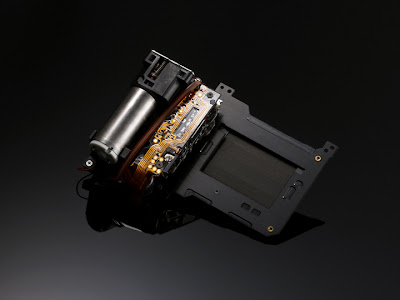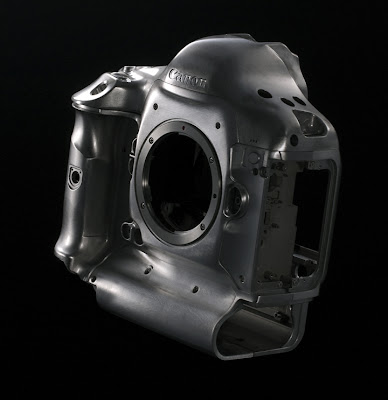If you like this post, help us share it
Canon has revealed its top of the line flagship – Canon EOS-1D X. It is equipped with a full-frame 18.1 Megapixel CMOS sensor and a new Dual DIGIC 5+ Image Processors deliver high quality image capture at up to 12 fps and a powerful ISO range of 100 – 51200 (up to 204800 in H2 mode). The EOS-1D X reach new levels of focus speed and accuracy delivering using 61-Point AF and 100,000-pixel RGB Metering Sensor powered by a DIGIC 4 Image Processor. Up to 41 of them will function as cross-type sensors that are able to detect contrast both horizontally and vertically with f/4 and faster lenses. The EOS-1D X’s improved HD video capture can now record up to 29mins 59secs at 1080: 30p. Durable construction with Magnesium alloy body and shutter durability tested to 400,000 cycles make this the ultimate EOS. Unfortunately, I am not a Canon User.

Front and back view of Canon’s new EOS-1D X



18.1 Megapixel full-frame CMOS sensor
The EOS-1D X features a newly developed Canon full-frame 18.1 Megapixel CMOS sensor that’s designed from the ground up to create high resolution. A full 24 x 36mm, the sensor captures 5184 x 3456 large individual 6.95 µm pixels and has a much-improved S/N ratio resulting in better images from the start. A new photodiode structure with an increased photoelectric conversion rate increases the sensor’s sensitivity by approximately 2 stops over previous models, meaning higher ISOs with the lowest noise of any EOS digital camera. And a 2-line 16-channel simultaneous signal readout means speeds of up to 12 fps (RAW + JPEG) and even 14 fps (Super High Speed Mode) are possible!
14-bit A/D conversion, wide range ISO setting 100-51200 (L: 50, H1: 102400, H2: 204800)
The EOS-1D X not only offers 14-bit signal processing for excellent image gradation, it delivers higher standard and expanded ISOs. With a standard range of ISO 100-51200 (up to 204800 on H2), the EOS-1D X represents a 2-stop increase in sensitivity over previous cameras.

Dual DIGIC 5+ Image Processors for enhanced noise reduction and blazing processing speed
The EOS-1D X uses Dual DIGIC 5+ Image Processors that include four 4-channel A/D converter front-end processing circuits and deliver speeds of up to 12 fps (RAW + JPEG) and 14 fps (JPEG). Compared with the predecessor, Canon’s DIGIC 4 Image Processor, the Dual DIGIC 5+ Image Processor offers approximately 17x faster processing speed, and feature new algorithms that promote greater noise reduction at higher ISOs. In addition to conventional image processing functions the Dual DIGIC 5+ Image Processors offer real-time compensation for Chromatic Aberration in both still and motion images. With the power of these two processors, speed improvements are noticeable from the instant the camera is turned on and the stunning results speak for themselves.

All new 61-Point High Density Reticular AF
The newly designed 61-Point High Density Reticular AF features an Offset Array Sensor (with staggering AF point arrangement). It offers multi-zone wide-area AF for better tracking, has 5 central dual cross-type points (f/2.8 diagonal), 21 central cross-type points (f/5.6 horizontal & vertical) and 20 outer cross-type points (f/4.0 horizontal), and is sensitive in extremely low-light situations (EV-2 for a central point with a f/2.8 lens).
The EOS-1D X has a dedicated AF menu tab, so AF can be controlled without having to go through custom function menus. It also has 6 AF point selection methods (Spot, Single Point, Single + Adjacent 4 Points, Single + Adjacent 8 Points, Zone Selection, and Automatic AF Point Selection), plus a dedicated AF configuration tool for control of AI Servo AF III tracking parameters (tracking sensitivity, acceleration/deceleration tracking, and AF point auto switching).
The EOS-1D X uses the 100,000-pixel RGB Metering Sensor to aid the AF system in Automatic Point Selection. This dramatically increases the tracking performance for subjects that were previously unpredictable to follow, such as fast-moving or flying subjects. EOS iTR (Intelligent Tracking and Recognition) AF recognizes the subject based on face and color detection from the AE system, and tracks it using AF points. The EOS iSA (Intelligent Subject Analysis) System incorporates color recognition and Face Detection for proper exposure.
A new 61-Point AF – 5 central dual cross-type points (f/2.8 diagonal), 21 central cross-type points (f/5.6 horizontal & vertical) and 20 outer cross-type points (f/4.0 horizontal)


100,000-pixel RGB Metering Sensor Powered by Canon DIGIC 4 Image Processor
The EOS-1D X features a brand new 100,000-pixel RGB Metering Sensor with a dedicated DIGIC 4 Image Processor that delivers substantial improvements in evaluative ambient and flash metering. The sensor has 252 distinct zones for general metering, with 35 zones used for low-light metering.
Shutter Durability for up to 400,000 cycles
Its newly redesigned shutter has lightweight and carbon-fiber blades, and is rated to maintain up to 14 fps performance without compromise, for up to 400,000 cycles. The EOS-1D X is the first 1-series Canon to feature an electronic first curtain. It comes to life in Live View’s Silent Shooting modes, and enables maximum camera stability in situations in which a high magnification lens (supertelephoto or microscope, for instance) and slow shutter speed is used.

Magnesium Ally Body, Dual Card Slots, Ethernet Port and 3.2” TFT LCD Monitor
The EOS-1D X is designed to perform superbly, even in the most treacherous environments, every time. The body is constructed of rigid, high-strength magnesium alloy for rugged performance and features a new grip design for easier finger placement and reduced hand fatigue.
EOS-1D X records to industry speed-leading CompactFlash cards and features Dual Card Slots.
The EOS-1D X’s 3.2" TFT LCD monitor has 1,040,000 dots, anti-reflective construction and features Canon’s Clear View II technology.
Wired image transfer is also speedier than ever thanks to the EOS-1D X’s built-in Gigabit Ethernet terminal

HD Movie
The EOS-1D X takes all of the current features and puts them into one camera as well as improving various aspects of the movie shooting for both better usability and better incorporation into professional workflows. This means there is the ability to shoot 1920×1080 at 24, 25 and 30fps, as well as 1280×720 at 50 and 60fps. Audio levels can be controlled manually, as found on the EOS 60D and EOS 5D Mark II, and the ISO range for movie shooting runs from ISO 100 to 51,200.
The biggest change to the movie shooting is the ability to choose from two different compression methods — IPB or ALL-I — depending on your needs. The EOS-1D X still records movies using the H.264 codec but it is the compression type within this codec that has been changed.
The Canon EOS-1D X is starting to ship at the end of March 2012. The expected U.S. street price has been set at US$6800.
You can pre-order yours at B&H.
Some actual Canon EOS-1D X photos from kingsize facebookpage. Check out their hands on review here.


sources: Canon USA. Rob Galbraith DPI kingsize facebookpage
Where can I find the equipment seen on this site?
If you find this site useful and planning to purchase any of the equipment seen on this site, please show your support by purchasing your photo equipment at B&H Photo Video, or through any of the affiliate links seen on this site.


